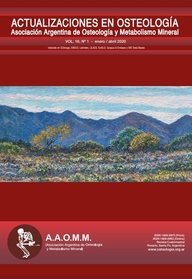Demostración original de la interferencia de los efectos modeladores corticales expansivos de un entrenamiento sobre los de otro ulterior (La modelación marca el terreno para la remodelación)
Autores: Leandro Pisani, Nicolás Pilot, Sergio Lüscher, Leandro Mackler, Laura M. Nocciolino, José L. Ferretti, Gustavo R. Cointry, Ricardo F. Capozza
Resumen
La expansión modeladora de la geometría cortical de un hueso inducida por su entorno mecánico podría ser difícil de modificar por estímulos ulteriores con diferente direcciona¬lidad. Este estudio, que por primera vez com¬bina datos tomográficos del peroné (pQCT) y dinamométricos de la musculatura peronea lateral, intenta demostrar que, en individuos jóvenes no entrenados, el entrenamiento en fútbol produce cambios geométricos pero¬neos expansivos, similares a los del rugby, que podrían interferir en los efectos de un en¬trenamiento ulterior direccionalmente diferen¬te (carrera larga).
Confirmando la hipótesis, los resultados indican, con evidencias originales, 1) la rele¬vancia creciente del uso del pie (rotación ex¬terna y eversión provocadas por los peroneos laterales) para la determinación de la geo¬metría peronea (incremento del desarrollo de los indicadores de masa y de diseño óseos), evidenciada por la secuencia creciente de efectos: carrera < fútbol < rugby; 2) la predo¬minancia de esos efectos sobre el desarrollo centro-proximal del peroné para resistir a la flexión lateral, y en la región distal para resistir el buckling (principal sitio y causa de fractura del hueso) y 3.) la relevancia de la anticipación de esos efectos para interferir en la manifes¬tación de los cambios producidos por un en¬trenamiento ulterior (carrera), cuando los del primero (fútbol) afectan la modelación cortical de modo expansivo.
Esta última deducción demuestra, en for¬ma inédita, que un cambio modelatorio ex¬pansivo tempranamente inducido sobre la estructura cortical ósea delimitaría el terreno para la manifestación de cualquier otro efecto ulterior por estímulos de distinta direccionali¬dad.
Palabras clave: biomecánica ósea, estruc¬tura ósea, mecanostato óseo, interacciones músculo-hueso, peroné.






